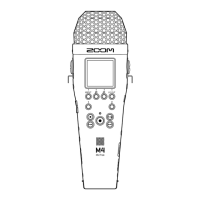
Do you have a question about the Zoom M4 MicTrak and is the answer not in the manual?
| Microphone Type | Condenser |
|---|---|
| Recorder Channels | 4 |
| Frequency Response | 20 Hz to 20 kHz |
| Max Input Level | +4 dBu |
| Gain Control | Yes |
| Power Source | Battery or USB |
| Battery Type | AA |
| Outputs | 1 x 1/8" (3.5mm) stereo headphone |
| Phantom Power | 48V |
| Display | 1.54" Color LCD |
| USB | USB-C |
| Recording Media | microSD, microSDHC, microSDXC |
Explanation of features ensuring high audio quality during recording and editing.
Details on the dual A/D converter design for enhanced dynamic range.
How the device switches between A/D converters for optimal recording results.
Benefits of using the 32-bit float WAV format for recording and editing.
Description of physical components on the front and back of the device.
Detailed explanation of the M4's operational buttons and indicators.
Guide to using operation buttons and icons for menu navigation and selections.
Description of ports and connectors located on the left and right sides of the M4.
Details on other ports like Time Code IN/OUT and MIC/LINE IN jacks.
Description of the Home Screen, showing recording status and input waveforms.
Overview of the Playback Screen, detailing playback status and file information.
Explanation of the FILE LIST Screen for checking and managing recorded files.
Guide to accessing and using the Menu Screen for device settings.
Essential preparation tasks before starting an audio recording session.
Instructions on how to properly insert and remove a microSD card.
Connecting AC adapters or portable batteries for continuous power.
Step-by-step guide for installing AA batteries into the M4.
Information on using the integrated stereo XY microphone for recording.
Guidance on connecting line-level audio devices using TRS plugs.
How to connect lavalier microphones using the MIC/LINE IN jack.
Examples of recording setups for voice, instruments, and concerts.
How to select the desired language for the device's display.
Configuring the date format for recording files.
Adjusting the device's internal date and time settings.
Selecting the battery type for accurate remaining charge display.
Activating and deactivating the button hold function.
Choosing which input (XY mic, Input 1, Input 2) to configure.
Changing the recording format for the built-in XY microphone (Stereo/Mono).
Setting input sources and enabling phantom power for Inputs 1 and 2.
Selecting the voltage for phantom power (+24V or +48V) for microphones.
Providing plug-in power to microphones connected via the MIC/LINE IN jack.
Applying a low-frequency cut filter to reduce wind and pop noises.
Controlling the audio level sent to external devices via the line out jack.
Customizing the volume indicator size on the display for better visibility.
How to monitor input signals and playback audio using headphones.
Choosing the sample rate for audio recordings (e.g., 44.1kHz, 48kHz).
Using the pre-recording feature to capture audio before pressing record.
Enabling a tone signal that plays when recording begins, useful for video synchronization.
Detailed steps for initiating and concluding audio recording sessions.
How to add markers to recordings while actively recording.
Procedures for initiating and terminating audio playback.
Detailed operations and functions available on the Playback Screen.
Managing markers on recorded files during playback.
Enabling automatic volume adjustment during playback for consistent loudness.
Understanding the M4's file organization and folder hierarchy.
Explanation of the naming convention used for recorded audio files.
Using the FILE LIST screen to view, play, and delete files.
Detailed functions and controls available on the FILE LIST Screen.
Steps to delete selected files directly from the FILE LIST screen.
How to delete a file currently playing on the Playback Screen.
Using normalization to adjust audio file volume to an optimal level.
Converting files to different bit depths and exporting them.
Viewing detailed information about a specific recorded file.
Guide for installing necessary drivers on Windows computers for USB mic use.
Steps for connecting the M4 to computers, smartphones, and tablets.
Temporarily muting the microphone output when using the USB mic function.
Proper procedure for disconnecting the M4 from connected USB devices.
Selecting stereo or mono output for the built-in XY mic in USB mode.
Applying a low-frequency cut filter to the built-in XY mic in USB mode.
Configuring the bit depth (e.g., 32-bit float) for USB microphone output.
Activating direct monitoring for zero-latency audio monitoring in USB mic mode.
Steps to connect the M4 to computers and devices for file transfer.
Proper procedure for disconnecting the M4 after file transfer.
Changing the language used for the device's display interface.
Configuring the device's internal clock for accurate file timestamping.
Selecting the preferred format for displaying dates in recorded files.
Configuring display backlight dimming to conserve battery power.
Adjusting the brightness level of the device's display.
Specifying the battery type for accurate remaining charge indication.
Configuring the automatic power-off timer to save battery.
Instructions for formatting microSD cards for optimal performance and compatibility.
Performing quick and full tests to check microSD card writing speed.
Executing a comprehensive test of the microSD card's performance.
Explanation of timecode and its use in video and audio synchronization.
Configuring the timecode mode (Off, Internal, External).
Matching frame rates for timecode synchronization with video sources.
Jamming internal timecode from an external timecode source.
Resetting the internal timecode value to zero.
Resetting all device settings to their original factory defaults.
Viewing the currently installed firmware version on the M4.
Instructions for updating the M4's firmware to the latest version.
Connecting and operating the M4 using optional remote controls.
Troubleshooting steps for problems related to audio recording and playback.
Addressing other operational issues, including USB connectivity and battery life.
List of metadata tags and their explanations contained in BEXT chunks.
Details on the number and type of input and output channels.
Specifications for recorder, display, USB, timecode, remote, and power.
Estimated battery life under various recording conditions.
